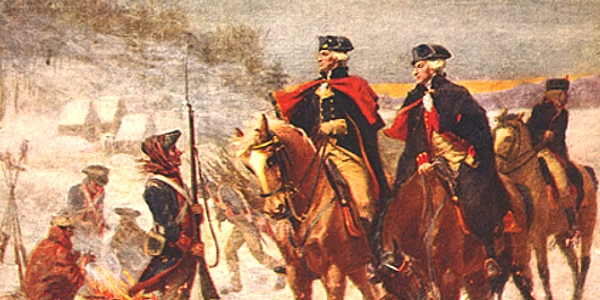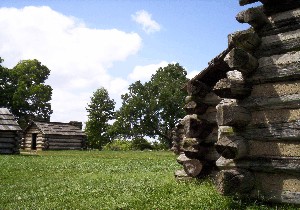
"We have this day no less than 2,873 men in camp unfit for duty because they are barefooted and otherwise naked." - George Washington, December 23, 1777.
Photo above: Recruiting poster from World War II, gives an indication of how the nation viewed the soldiers of 1777-8, ... resourceful and willing to sacrifice. Source: National Archives. Right: Washington and his troops around the headquarters area. Source: Library of Congress.

Valley Forge
It was not the intention of George Washington to encamp along the Sckuylkill River west of Philadelphia with the British Army in possession of the nation's capital, Philadelphia. He had spent the better part of the fall of 1777 in losing battles with the British at Brandywine and Germantown, plus a good amount of feint and march, attempting to forestall their progress to occupy Philadelphia and Reading where a large amount of Federal supplies were stored. Somehow as Washington bridged the gap between those locations, the road to Philadelphia became open, and now, he was forced to winter on the plains of Valley Forge, in 2,000 rough log huts that would test whether a man could withstand a cold, wet winter and live to fight the next spring. For many men in the 11,000 strong Continental Army at Valley Forge, this would be their last winter. Valley Forge would see to that for nearly 2,000 soldiers, although the reason for their demise was mostly disease.
Sponsor this page. Your banner or text ad can fill the space above.
Click here to Sponsor the page and how to reserve your ad.

Valley Forge Then
Different than most battlefield oriented parks, Valley Forge is as much memorial as location to recall activity. It was the location of a winter encampment where the men of the Continental Army trained under General Baron von Steuben and became an efficient fighting force, and while that should not be overshadowed and lessened in importance, much of the Valley Forge story centers around the harshness of the camp and the loss of life while there. With spring, the troops of Washington that had endured those harsh conditions left Valley Forge an improved force, with a new alliance with France in force as of May 1778. With the French recognition and their impending arrival, the British army evacuated Philadelphia in June 1778, with George Washington marching out of his Valley Forge camp on June 19 of that year to regain Philadelphia and follow the British into New Jersey.
Von Steuben and Formation - Although most of the Valley Forge encampment was spent trying to outlast the winter and overcome disease, it was the system of field formations developed and perfected by the Prussian general which had the most lasting effect on the fledgling nation. When the battles of 1778 would occur, mostly in New Jersey, the efficiency of the soldiers in battle had been greatly improved.
The Continental Soldier - Beginning in 1777, the majority of men in the Continental Army were three year recruits, or for the remainder of the war, if it lasted more than three years. They had been engaged in battles throughout southeast Pennsylvania in the fall of 1777 from Brandywine to the Battle of the Clouds, Paoli, and Germantown, marching between the Delaware border toward Reading into Philadelphia and eventually wintering in Valley Forge as the British commanded the city.
The Battle Campaign Timeline
British land at Head of Elk, Turkey Point, Chesapeake Bay - 8/25/1777
American Position, Newport, Delaware - 8/25/1777
Battle of Brandywine - 9/11/1777
Battle of the Clouds - 9/16/1777
March to Washington's Furnaces - 9/18/1777
Paoli Massacre - 9/20-21/1777
British occupation of Philadelphia - 9/26/1777
Battle of Germantown - 10/4/1777
Battle of Red Bank, New Jersey - 10/22/1777
Battle of Fort Mifflin - 11/10-11/15/1777
Battle of Whitemarsh - 12/5-8/1777
Valley Forge Encampment Begins - 12/19/1777
Valley Forge Encampment Ends - 6/19/1778
Image above: General George Washington and the Marquis de Lafayette on horseback at Valley Forge. Painting by John Ward Dunsmore, 1907, courtesy Library of Congress. Below: Valley Forge's National Memorial Arch.

Valley Forge Now
A visit to Valley Forge has been undergoing a dramatic change with increased interpretation at many areas, not only the heavily visited Muhlenberg Huts or Washington Headquarters. The park is much more than that or a place to take a walk, as the suburban nature of the location has pushed toward recreation as well as history. Talks and other programs are available throughout the year, and a visit to the Washington Chapel, the final stop on the tour road, should not be missed.
A visit to Valley Forge on your Philadelphia or Pennsylvania vacation is a must if you wish to understand sacrifice, ... sacrifice for an ideal that had yet been tried, but would eventually lead to the first democratic nation that would fulfill the destiny proclaimed in the Declaration of Independence and later codified in the Constitution.
The Grand Parade Ground - In the open fields of Valley Forge, General Van Steuben created an effective fighting force among the men who lasted the winter camp. Although less famous than the log huts that dot the site, it was perhaps in this field that the most lasting import of the Valley Forge history was made. The training here gave Washington's men the chance to win the war. Starting in 2019, a new trail has been developed within the parade grounds with interpretive markers to come. This is an open field, therefore potentially sunny and hot, so dress accordingly and bring plenty of water and bug spray.
Soldier's Quarters - The log huts of the Muhlenberg brigade are examples of the two thousand cold structures that dotted the avenues of Valley Forge and were home to the eleven thousand men encamped there. Beyond these huts, which they constructed upon arrival, the men also dug redoubts and built a bridge across the Schuylkill River.
The National Memorial Arch - Dedicated in 1917 to commemorate the value and sacrifice that the men of Washington exhibited during their stay at Valley Forge, the Memorial Arch serves as the largest and most visible reminder to the many prayers for sustenance and independence that raged throughout the Revolutionary War.
Note - The main Visitor Center at Valley Forge, which had been closed for reconstruction for several years, is now open again, with Visitor Services, the Encampment Store, new exhibits, and a new film about the park.
Minute Walk in History
Check out our Valley Forge entry in our Minute (or Two) Walks in History. This time, it's the Headquarters of Valley Forge, but there's more to that than just Washington's headquarters on the Auto Tour. Walk with us to three more in somewhat hidden locations about the park; i.e. General Knox, General Lafayette, and General Stirling, then try to find them when you get the chance to visit.
For Other Videos of Valley Forge
Youtube - Grand Parade Walk, including the training ground of General Von Steuben as he formed the Continental Army into an effective fighting force, as well as the limestone pit, they won't tell you the location, where prehistoric bears, tigers, and other creatures were found, and are now on display at the Visitor Center and other natural museums.
T-Shirts and Souvenirs

Valley Forge T-Shirts and Souvenirs. Official gifts from Americabesthistory.com provided at Teepossible.

Valley Forge
Things You Should Not Miss
1. Dip inside a log hut and close the door. Now imagine yourself stuck inside the small, drafty hut with cold winds seeping through the cracks. Do that for three or four months, then add in cold training to become a better fighting force, and you get the idea of what life was like here.
2. Take in the ranger guided talk/walk around the restored Washington's headquarters area and the headquarters itself. Although this was certainly not a Mount Vernon type structure, there was a grand difference between being a typical soldier stuck inside the log huts that dotted the entire landscape of the park at that time and being a general in the Continental Army.
3. Walk up to the National Memorial Arch and take a look over the landscape. What you'll see is almost a recreational atmosphere of children playing, kites flying, joggers jogging, and unfortunately, a skyline in the background for the King of Prussia condominiums. Take a breath and realize that if it was not for Washington's men giving democracy and freedom a chance with their lives here at Valley Forge, none of that would have been possible.
4. Take advantage of the special walks and talks, such as the Soldiers Walk Into Camp program in winter, around the December 19 date of the actual time Washington got to Valley Forge, or the Soldiers Walk Out, around the June 19 date Washington left Valley Forge, prompted by the British evacuating Philadelphia. Yes, they were there six months, all the time while the British dined in Philly. And why did the British finally leave Philadelphia? Well, they were afraid, after the USA alliance with France that France would blockade the Delaware Bay and not allow them to leave. Thanks, France.
Photo above: Washington's headquarters today. Open to visit with guided walks/talks during summer months. Below: One bedroom on the second floor of the rented headquarters home, in period furnishings.


Get Baseball History and Books at Stat Geek Baseball, including Baseball's Best @ 150.
Visitor FAQ












